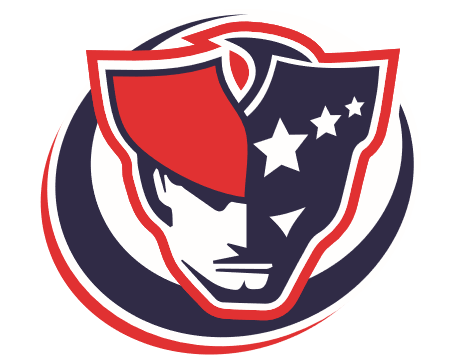Tar Heels. Blue Devils. Demon Deacons. Wolfpack.
Even for the uninitiated, these names immediately bring to mind the schools they represent. Part marketing genius, part sports fan fodder, mascots take sight recognition and team pride and turn it up to ten, and in doing so contribute to a relatively recent cultural phenomenon.
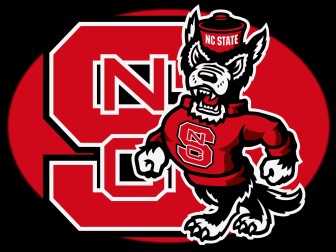
The NC State Wolfpack Logo should be immediately familiar to any Raleigh resident
From a mascot marriage officiated by the opposite team to a fantastical creature who guest-starred on 30 Rock, mascots have come a long, long way from the first usage of the word in a late-1800’s French comedic opera.
Humorous, charismatic and inescapably visible, mascots are the costumed embodiment of school and team spirit. But where do mascots come from, and why are they chosen?
In August 2015, Wake County announced it would be opening 13 new schools over the next five years, bringing the total number in the system to 184. Of the existing facilities, 159 are traditional elementary, middle and high schools.
Each of those schools has its own mascot, and we’ve compiled a list of all Wake County Schools and their mascots. If we got your school mixed up, please let us know!
The Record was told that most mascots are chosen by the school’s principal and approved by the superintendent.
Repeat mascots are common throughout the school system: 14 schools chose a cougar, 7 a bulldog, 7 a panther and so on. The most creative names by far belonged to schools in Apex, whose names — Lightning, the Bluegills, the Clipper Ships, the Penguins, the Salamanders, the Sailors and the Wallabies were not replicated elsewhere.

A Rich History
Outside of the Wake County School System, the process of choosing a mascot, and the history behind it, is more complex than one might imagine.
The commonly–cited etymology of the term “mascot” comes from the French word “mascotte”, popularized by an eponymous comedic operetta about a girl who brings good luck to a struggling farmer. The term itself is a feminized version of the French-Provençal masco, slang for witch or sorcerer.
In its original usage, mascots were good-luck charms — as animator and animal symbolism writer David Wolter explains, the operetta’s first song, “Legend of the Mascots”, describes mascots as “God’s attempts to combat Satan’s minions”.
While the original mascot concept seems to be a far cry from team mascots of today, the root of this French import remains intact: mascots are the visual representation of fan hopes for victory, and by cheering for a team wearing a mascot’s likeness, we, in turn, imbue them with the power the mascot represents.
It’s no accident that many mascots are fierce humans (think Blue Devils or Forty-Niners) or animals (Eagles, Falcons, Bulldogs) that possess qualities meant to intimidate the opposing teams.
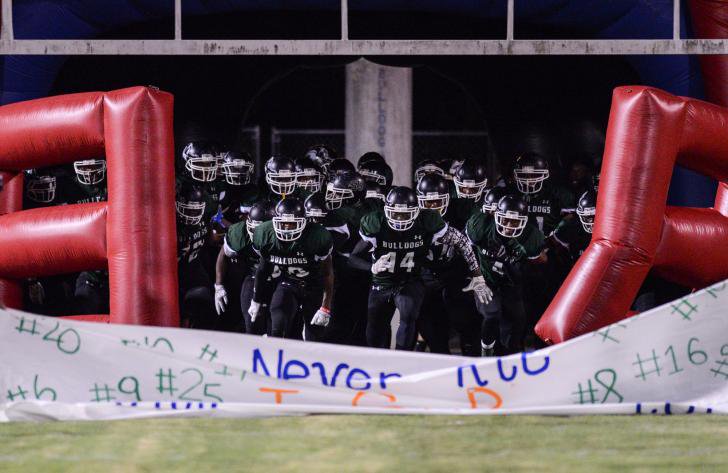
Southeast Raleigh Bulldogs
If they didn’t call themselves the Bulldogs, this image wouldn’t be in the least bit intimidating
Here in Wake County, our mascots run the gamut from Lions to Wildcats, Wolverines to, of course, the Wolfpack, and everything in-between. Mascots are chosen for desired qualities like strength, swiftness and agility — but what factors were considered in choosing mascots for Wake County teams?
In more than one case, racial integration played a role. According to J. Mike Blake, the News & Observer’s sports commentator, some schools chose to change their mascots to represent the positive changes of integration.
“Many schools changed names and even added new colors after integration to be more unified,” Blake said. “Fuquay-Varina (formerly Fuquay Springs) went from Falcons to Bengals and now the tiger is a symbol of the town. Cary [Imps] didn’t change their name, but they did drop the “White” from “White Imps” so nobody got the wrong idea.”
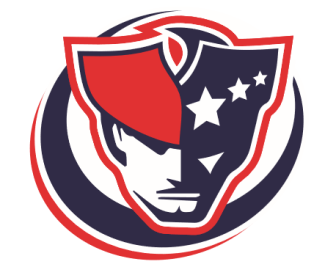
The Apex Friendship Patriot
The actual process of mascot selection for newer schools is an exercise in self-determination — school officials choose an animal (or, in some cases, a “type” of person) that instantly identifies their team as brave, strong, and unweilding, and run with it. In the case of one newer Wake school, the mascot was specifically chosen to offset a perceived weakness — the Apex Friendship Patriots.
“They wanted something strong since the community thought “Friendship” in the title insinuated weakness,” Blake said. Plus, he added, too many schools in Wake County already had birds and other animals as mascots.
In recent years, more attention has been paid to those behind the mascot costumes, as evidenced by the success of David Raymond, the original Phillie Phanatic, Christopher Guest’s forthcoming Netflix-exclusive film “Mascots” and the 2014 publication of “Yes, It’s Hot in Here by ESPN.com writer and former Mr. Met AJ Mass’s” about the history of mascotting.
“Being Mr. Met was a bizarre and unique experience,” Mass said. “Don’t get me wrong, there’s a lot of fun to be had, but when you do the job right, people forget there’s an actual person inside the suit and as a result, the performer (once he takes the suit off) gets forgotten.”
In “Yes, It’s Hot in Here”, Mass asserts that mascots are the modern equivalent of “fools” or court jesters whose comedic exploits embolden their teams to victory.
His recounting of the events that followed the success of “La Mascotte” — a translated rendition, “The Mascot”, debuting in England that made its’ way to Boston and then New York — accounted for its adoption into the American lexicon so thoroughly that Ivy League schools began adopting “mascottes” of their own, with Yale’s “Handsome Dan”, a bulldog, as the first live mascot in the late nineteenth and early twentieth centuries.
The key to a successful mascot, according to Mass, lies in the fine line between being entertaining while not taking attention away from the team.
“The performer must be able to play to the back row of the stadium but also relate with an individual fan one-on-one,” Mass said. “They need a sense of fun in terms of performing, but professionalism in terms of being prepared both physically and mentally for the job.”
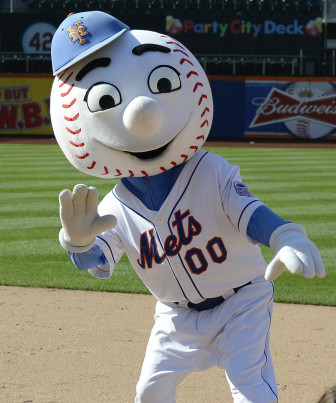 A mascot’s job, Mass emphasized, isn’t easy work — and when watching any good mascot, it’s not hard to see why. They dance, jump around, perform unwieldy sight gags in costume, all to get a laugh from the audience and, perhaps more importantly, focus fans’ attention on their team to help inspire them toward the coveted win.
A mascot’s job, Mass emphasized, isn’t easy work — and when watching any good mascot, it’s not hard to see why. They dance, jump around, perform unwieldy sight gags in costume, all to get a laugh from the audience and, perhaps more importantly, focus fans’ attention on their team to help inspire them toward the coveted win.
In short, the person in the mascot costume has a huge responsibility, and Mass urged caution in mascot-selection.
“A lot of organizations sadly don’t realize there’s a need to pay special attention to whom they pick,” Mass said.
“A mascot is the single most important public relations and marketing tool at a sports organization’s disposal and yet, time and again, teams fail to realize the value and importance of making sure the person inside the suit is capable to handle that responsibility.”
As the new Wake County schools open over the coming years, the process of choosing mascots, those modern-day totems, will be continually underway as all the hopes and dreams of their new administrators become fleshed out — literally — in costume. They’ll be lucky, literally and figuratively, to call Wake County, a region with a large and festive sports culture, their home.
